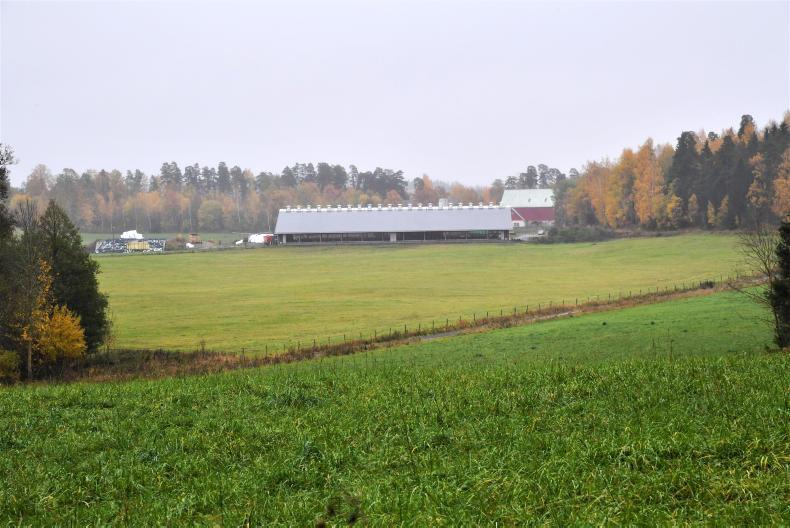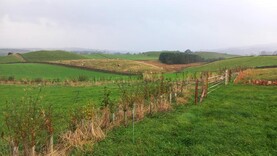My family has been farming here at Lindö since 1816 and I’m the sixth generation to farm here. Along with my wife Sussie, I farm 600 acres of land and own a little over 3,700 acres of forestry. The farmland is divided into 345 acres in grass with the remaining 255 acres in tillage. I mainly grow oats and barley on the tillage land which I use as feed for my cattle.

Finnish dairy farmer Jan de la Chapelle milks 180 cows in a housed system. \ Copyright: European Union 2019. Photographer: Cornelia Smet.
I milk 180 Holstein cows which have an average production of 12,000 litres every year. The cows are milked by three robots roughly three times a day. This spring, one of my cows produced her 100,000th litre of milk, which I was very proud of.
Sometimes I play hard rock music (which is famous in Finland) or some John Mayer for the cows inside the barn. I think they like it.
The cows are fed on a diet of barley, oats and grass that we produce ourselves here on the farm but I also need to buy in some concentrates as I can’t produce enough feed to be self-sufficient.

Finnish dairy farmer Jan de la Chapelle milks 180 cows in a housed system. \ Copyright: European Union 2019. Photographer: Cornelia Smet.
More of the protein concentrates that we use are beans, peas and oilseed crops.
We don’t use soya anymore in Finland because the country stopped importing it about five years ago.
In total, my farm produces about 2m litres of milk every year. I supply my milk to Valio, which is a farmer-owned co-op that processes about 80% of all the milk in Finland.

Finnish dairy farmer Jan de la Chapelle milks 180 cows in a housed system. \ Copyright: European Union 2019. Photographer: Cornelia Smet.
The dairy industry in Finland is still struggling with the impact of the Russian ban on European food imports back in 2014.
Before the ban, Finland used to export the equivalent of 500m litres of milk to Russia every year. Now we export nothing. It’s only 500km to St Petersburg from here so it was a very close export market for us.
Milk prices today are currently at 35.6c/l, which is only 1c to 2c above the EU average and bordering on the breakeven point for many dairy farmers in Finland.

Finnish dairy farmer Jan de la Chapelle milks 180 cows in a housed system. \ Copyright: European Union 2019. Photographer: Cornelia Smet.
Like many parts of Europe, production costs only continue to rise in Finland. I need EU subsidies to make a living because my farm is only at breakeven or slightly better with milk prices at 35c/l.
Before the Russian ban the average milk price in Finland was about 45c/l. Dairy farmers in Finland have seen our milk prices slashed by 10c/l since the ban.

Finnish dairy farmer Jan de la Chapelle milks 180 cows in a housed system. \ Copyright: European Union 2019. Photographer: Cornelia Smet.
It is the Finnish farmers who are paying the price for the EU’s dispute with Russia after it invaded parts of Ukraine in 2014. The Russian ban on importing EU food is costing me roughly €100,000 per annum.
In the first year after the ban, Finnish farmers got some compensation from the EU and the Finnish government. But now everyone has forgotten about the impact of the ban, even though dairy farmers are still left feeling its effects every year, and the compensation supports are all gone.
My family has been farming here at Lindö since 1816 and I’m the sixth generation to farm here. Along with my wife Sussie, I farm 600 acres of land and own a little over 3,700 acres of forestry. The farmland is divided into 345 acres in grass with the remaining 255 acres in tillage. I mainly grow oats and barley on the tillage land which I use as feed for my cattle.

Finnish dairy farmer Jan de la Chapelle milks 180 cows in a housed system. \ Copyright: European Union 2019. Photographer: Cornelia Smet.
I milk 180 Holstein cows which have an average production of 12,000 litres every year. The cows are milked by three robots roughly three times a day. This spring, one of my cows produced her 100,000th litre of milk, which I was very proud of.
Sometimes I play hard rock music (which is famous in Finland) or some John Mayer for the cows inside the barn. I think they like it.
The cows are fed on a diet of barley, oats and grass that we produce ourselves here on the farm but I also need to buy in some concentrates as I can’t produce enough feed to be self-sufficient.

Finnish dairy farmer Jan de la Chapelle milks 180 cows in a housed system. \ Copyright: European Union 2019. Photographer: Cornelia Smet.
More of the protein concentrates that we use are beans, peas and oilseed crops.
We don’t use soya anymore in Finland because the country stopped importing it about five years ago.
In total, my farm produces about 2m litres of milk every year. I supply my milk to Valio, which is a farmer-owned co-op that processes about 80% of all the milk in Finland.

Finnish dairy farmer Jan de la Chapelle milks 180 cows in a housed system. \ Copyright: European Union 2019. Photographer: Cornelia Smet.
The dairy industry in Finland is still struggling with the impact of the Russian ban on European food imports back in 2014.
Before the ban, Finland used to export the equivalent of 500m litres of milk to Russia every year. Now we export nothing. It’s only 500km to St Petersburg from here so it was a very close export market for us.
Milk prices today are currently at 35.6c/l, which is only 1c to 2c above the EU average and bordering on the breakeven point for many dairy farmers in Finland.

Finnish dairy farmer Jan de la Chapelle milks 180 cows in a housed system. \ Copyright: European Union 2019. Photographer: Cornelia Smet.
Like many parts of Europe, production costs only continue to rise in Finland. I need EU subsidies to make a living because my farm is only at breakeven or slightly better with milk prices at 35c/l.
Before the Russian ban the average milk price in Finland was about 45c/l. Dairy farmers in Finland have seen our milk prices slashed by 10c/l since the ban.

Finnish dairy farmer Jan de la Chapelle milks 180 cows in a housed system. \ Copyright: European Union 2019. Photographer: Cornelia Smet.
It is the Finnish farmers who are paying the price for the EU’s dispute with Russia after it invaded parts of Ukraine in 2014. The Russian ban on importing EU food is costing me roughly €100,000 per annum.
In the first year after the ban, Finnish farmers got some compensation from the EU and the Finnish government. But now everyone has forgotten about the impact of the ban, even though dairy farmers are still left feeling its effects every year, and the compensation supports are all gone.











 This is a subscriber-only article
This is a subscriber-only article










SHARING OPTIONS: